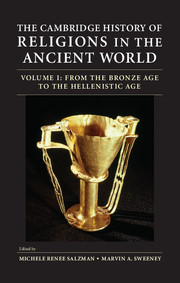Book contents
- Frontmatter
- Contents
- List of Figures and Maps
- List of Contributors
- List of Abbreviations
- Acknowledgments
- Introduction to Volumes I and II
- Introduction to Volume I
- Part I Mesopotamia and the Near East
- Part II Egypt and North Africa
- Part III Greece and the Eastern Mediterranean
- Part IV The Western Mediterranean and Europe
- Suggestions for Further Reading
- General Index
- Index of Citations
- Frontmatter
- Contents
- List of Figures and Maps
- List of Contributors
- List of Abbreviations
- Introduction to Volume II
- Part I Iran and the Near East
- Part II Egypt and North Africa
- Part III Greece and Asia Minor
- Part IV Italy, Roman Gaul, and Spain
- 14 Religion in Rome and Italy from the Late Republic through Late Antiquity
- 15 Judaism in Italy and the West
- 16 Christianity in Italy
- 17 Religions and Cities in Roman Gaul (First to Fourth Centuries CE)
- 18 Christianity in Gaul
- 19 Religions of Roman Spain
- Suggestions for Further Reading
- General Index
- Index of Citations
- References
19 - Religions of Roman Spain
from Part IV - Italy, Roman Gaul, and Spain
Published online by Cambridge University Press: 05 October 2013
- Frontmatter
- Contents
- List of Figures and Maps
- List of Contributors
- List of Abbreviations
- Acknowledgments
- Introduction to Volumes I and II
- Introduction to Volume I
- Part I Mesopotamia and the Near East
- Part II Egypt and North Africa
- Part III Greece and the Eastern Mediterranean
- Part IV The Western Mediterranean and Europe
- Suggestions for Further Reading
- General Index
- Index of Citations
- Frontmatter
- Contents
- List of Figures and Maps
- List of Contributors
- List of Abbreviations
- Introduction to Volume II
- Part I Iran and the Near East
- Part II Egypt and North Africa
- Part III Greece and Asia Minor
- Part IV Italy, Roman Gaul, and Spain
- 14 Religion in Rome and Italy from the Late Republic through Late Antiquity
- 15 Judaism in Italy and the West
- 16 Christianity in Italy
- 17 Religions and Cities in Roman Gaul (First to Fourth Centuries CE)
- 18 Christianity in Gaul
- 19 Religions of Roman Spain
- Suggestions for Further Reading
- General Index
- Index of Citations
- References
Summary
Dramatic regional differences within the Iberian Peninsula were always characteristic of the religious history of ancient Spain. Although long predating the Roman conquest, these differences are accessible to the modern scholar only as a result of the Roman conquest. Roman conquest brought with it religious practices, chief among them the habit of inscription, which have left traces in the material record. The religious diversity of Iberia followed directly from the enormous cultural differences between the coasts and the interior, the river valleys, the mountain chains, and the vast plateaus of the central peninsula. This cultural diversity was never wholly erased, not even with the spread of Christianity in the fourth and later centuries.
Nonetheless, the arrival of Roman armies in the peninsula, and thereafter the slow and bloody process by which Spain was made part of the empire, caused very significant changes to the peninsula’s religious life. For many years, these changes were intermittent and highly regional, but three periods of accelerated change affected the whole peninsula. The first of these took place during and immediately after the long reign of Augustus (r.27 BCE–14 CE), who had taken a personal interest in the final conquest of the peninsula and its incorporation into the empire. The Augustan reorganization of Spain placed every corner of the peninsula within a framework of Roman government in which Roman religious practices could spread rapidly. The second period of intense religious change began under the Flavian emperors, when Vespasian (r.69–79) extended the Latin right, a subordinate form of Roman citizenship, to every municipality in Spain that had previously lacked status under Roman law. This had the effect of giving every city in Spain a stake in the Roman system; as a result, both the cult of the Roman emperors and other Roman modes of public religious practice became universalized. The final period of accelerated change came with the imperial conversion to Christianity, as the new religion of the Roman state transformed the religious life of the Spanish provinces just as it did elsewhere. A diachronic perspective on the religious diversity of ancient Spain will perhaps be more useful than a synchronic catalogue of the religions, cults, and divinities of the peninsula, particularly given the necessary superficiality of such surveys. In the first instance, however, it will be worth sketching the broad differences among the various regions of the peninsula.
- Type
- Chapter
- Information
- The Cambridge History of Religions in the Ancient World , pp. 510 - 532Publisher: Cambridge University PressPrint publication year: 2013



